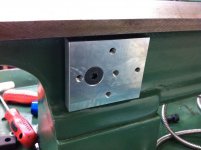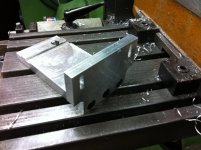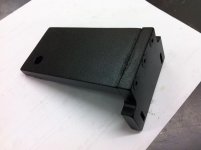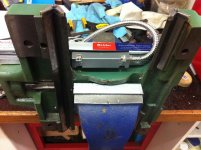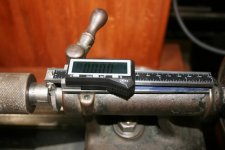Ok job is done and bottled up, though I've been away a lot lately so haven't had much opportunity to use it in anger.
As I suggested above, I replaced the square head bolts with grub screws on the compound, something I think is better anyway. I tend to leave my compound at around 28 degrees so I can thread without having to change anything, and at that setting the top slide makes getting to one of the locking bolts awkward. I can get an allen key in there much easier. I took a photo of the headstock side, as the other side is difficult to see.
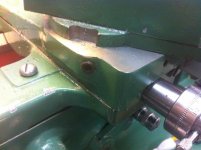
This is the tailstock view of the X axis scale. I finished up taking the cover off for the moment, as it needs to be removed to get even an allen key in to the compound locking grub screw. As I said all along, it's a VERY tight fit to get this all in there! It's only 2 screws and no big deal to whip the cover off (as mentioned, I tend to leave my compound on 28 degrees unless I'm cutting a taper etc, so it's not like I'm doing it every day), however the screw is also covered by the top slide at this angle What I'll most likely do is modify the cover to bring a bracket down to the front and put a knurled know in there and at the back to replace the 2 screws. I think the best way to tackle this will emerge with use. I don't like to require more tools to make adjustments to the lathe than I need to, so taking out the requirement for a screw driver is a good thing in itself. While I cleaned up the X bracket from the shots above when i was fabricating it, i didn't ever think it would be seen so didn't fuss over it. I think things look a lot neater with the cover in place, and it serves to protect the scale from the tailstock ramming in to it, so I'll certainly try to work out a way to get the cover back on where it doesn't become a PIA in use.

The back of the machine, sorry about the poor quality photo. Next time I'm at Jaycar or similar I'll pick up some black spiral cable wrap and wrap the cables. I have coolant, light, and the two DRO armoured cables so I just secured them together with cable ties for the moment. The wrap I have here is too thin to do all that I think, and I'll need some heavier duty wrap. The bundle then feeds up over the top of the splash back. I can traverse the length of the bed without anything getting tight or the cables dragging through the chip tray. They just hang down the back of the machine where they can't be seen and are out of harm's way. I like to keep crap out of my chip tray, as makes clearing the chips easier.

I don't know if this photo means that much, but is a closer look at the back. Everything is in the same position as before and nothing is adversely affected in the lathe operation as far as I can tell. The loops in the DRO cable on the X scale is very deliberate as it's the minimum bending radius and it needs to be in that position so as not to snag the scale when the cross slide is would back in.

Here's the completed machine, again another crappy photo. Maybe I had grease on the lens of something, I don't know. I have a cabinet drawer full of QCTP holders and I may build a rack for at least some of the more common ones I use all the time at the machine, and number the holders. The DRO can be programmed with tool offset, and that would be a handy feature. When I'm working I tend to keep my QCTP tools in the tray just to the left of the tailstock when I'm swapping them in and out, but it's not a very eloquent solution at the best of times. A rack would be much better and I have a design in mind using some left over aluminium extrusion I was using for T-slot in woodworking jigs, and that should tidy things up considerably.

All in all I'm pleased and haven't come across anything that is a major head slap moment where I discovered I can't [insert idiot moment here]. Obviously I can't get the tailstock quite as close to the carriage as I could previously, but whether that's going to be an issue remains to be seen. The functions on all these Chinese readouts seem to be very similar from what I've seen in reading through the manuals, and I've already found a couple of gotcha's if measuring taper when in diameter mode. The main advantage I think will be with the Z to be honest, as accurately measuring longer lengths was always a bit of a PIA previously. I haven't used the tool offset function yet, but that's also one I'm looking forward to using as I tend to use different inserts depending on whether I'm hogging off material compared to finishing.
The readout itself is bolted to the wall. I would have preferred it over the headstock, and it will reach across there, but obviously on this lathe design I need to open the cover very regularly. I didn't want the DRO in line with the chuck (the stain on the wall says all), quite apart from not reaching over the chuck. It seems ok where it is, but these are only small lathes, so I can put it pretty much anywhere along it I like.
That's about it. Other than the few things I mentioned above, I'm calling that one done and good to go.








